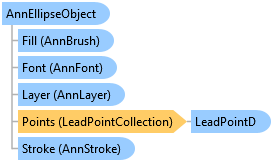| Leadtools.Annotations.Core Namespace : AnnEllipseObject Class |

public class AnnEllipseObject : AnnRectangleObject, IAnnObjectCloneable
Public Class AnnEllipseObject Inherits AnnRectangleObject Implements IAnnObjectCloneable
public sealed class AnnEllipseObject : IAnnObjectCloneable
@interface LTAnnEllipseObject : LTAnnRectangleObject<NSCoding,NSCopying>
public class AnnEllipseObject extends AnnRectangleObject
function Leadtools.Annotations.Core.AnnEllipseObject()
The ellipse annotation object is a simple ellipse defined by a bounding rectangle, a brush and a stroke.
Programmatically, the boundaries and location of the ellipse object can be controlled using the following properties:
Each object can be transformed with the following methods:
The AnnEllipseObject class inherits a number of properties from the AnnObject class, providing support for font, stroke and fill characteristics. These properties are listed below:
The name of the ellipse object can be controlled using AnnObject.Labels property, inherited from the AnnObject class.
An object can be part of a group annotation object or part of a container object. It cannot be part of both a group and a container at the same time.
The following properties can also be used to programmatically set characteristics of an AnnEllipseObject:
 Copy Code
Copy Code
using Leadtools.Annotations.Automation; using Leadtools.Annotations.Core; using Leadtools.Codecs; using Leadtools.WinForms; public void AnnCore_AnnEllipseObject() { // assumes _automation is valid double inch = 720.0; // Add a filled ellipse object AnnEllipseObject ellipseObj = new AnnEllipseObject(); // Set the points for the ellipse ellipseObj.Points.Add(LeadPointD.Create(1 * inch, 1 * inch)); ellipseObj.Points.Add(LeadPointD.Create(2 * inch, 1 * inch)); ellipseObj.Points.Add(LeadPointD.Create(2 * inch, 2 * inch)); ellipseObj.Points.Add(LeadPointD.Create(1 * inch, 2 * inch)); // Set the stroke ellipseObj.Stroke = AnnStroke.Create(AnnSolidColorBrush.Create("Red"), LeadLengthD.Create(3)); // Set the fill ellipseObj.Fill = AnnSolidColorBrush.Create("Green"); // Add the object to the automation container _automation.Container.Children.Add(ellipseObj); // Select the object _automation.SelectObject(ellipseObj); }
using Leadtools.Converters; using Leadtools.Annotations.Automation; using Leadtools.Controls; using Leadtools.Annotations.Core; using Leadtools.Codecs; [TestMethod] public void AnnCore_AnnEllipseObject() { // assumes _automation is valid double inch = 720.0; // Add a filled ellipse object AnnEllipseObject ellipseObj = new AnnEllipseObject(); // Set the points for the ellipse ellipseObj.Points.Add(LeadPointDHelper.Create(1 * inch, 1 * inch)); ellipseObj.Points.Add(LeadPointDHelper.Create(2 * inch, 1 * inch)); ellipseObj.Points.Add(LeadPointDHelper.Create(2 * inch, 2 * inch)); ellipseObj.Points.Add(LeadPointDHelper.Create(1 * inch, 2 * inch)); // Set the stroke ellipseObj.Stroke = AnnStroke.Create(AnnSolidColorBrush.Create("Red"), LeadLengthDHelper.Create(3)); // Set the fill ellipseObj.Fill = AnnSolidColorBrush.Create("Green"); // Add the object to the automation container _automation.Container.Children.Add(ellipseObj); // Select the object _automation.SelectObject(ellipseObj); }